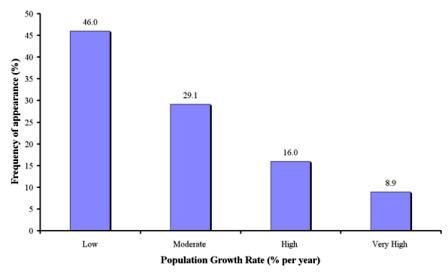Population growth rate
Population growth rate is a measure of change of population of a certain area. The rate of population growth is identified by Agenda 21 of the United Nations as one of the crucial factors affecting long-term sustainability of natural resources. Rapid population growth can impose limitations on a country's capacity for handling a wide range of economic, social, and environmental issues, particularly when rapid population growth occurs in conection with poverty and lack of access to natural resources.
Population Growth Rate (PGR) has been calculated as the increase in population during a period of time, usually one year, expressed as a percentage of the population at the beginning of the period. It corresponds to the number of births and deaths during the certain period and the number of people migrating to (immigration) and from (emigration) a country. (Source: http://www.worldbank.org/depweb/english/modules/social/pgr). The following equation has been used for calculating population growth rate (PGR) in the study sites:
![]()
The following classes have been defined for this indicator: (a) low population growth rate- PGR <0.2% per year, (b) moderate- PGR = 0.2-0.4% per year, (c) high- PGR = 0.4-0.6% per year, and (d) very high-PGR>0.6% per year. Data for the above calculation have been taken from the National Statistical Service of the study sites.
Data for this indicator have been defined in 1065 field test, corresponding to 10 study sites (Table 14). As Fig. 96 shows, the dominant class of population growth rate is low (growth rate <0.2% per year), covering 46.0% of the study field sites. Such population growth rate has been defined in the all cases of the study sites of Eskisehir-Turkey, and Konya Karapinar, and in some cases in the study sites of Santiago Island-Cape Verde, Novij Saratov-Russia, Djanybek-Russia, Mamora Sehoul-Morocco, Cointzio Catchment-Mexico, and Zeuss Koutine-Tunisia. Moderate population growth rate has been defined in 29.1% of the study field sites, corresponding to the study sites of Novij Saratov-Russia, Djanybek-Russia, Cointzio Catchment-Mexico, Santiago Island-Cape Verde, Guadalentin Basin Murcia-Spain, and Zeuss Koutine-Tunisia. The next important class of growth rate is high (0.4-0.6% per year), covering 16.0% of the study field sites, and corresponding to the study sites of Santiago Island-Cape Verde, Cointzio Catchment-Mexico, and Crete-Greece. Very high population growth rate has been defined in 8.9% of the study field sites, corresponding to some cases of the study sites of Boteti Area-Botswana, Secano Interior-Chile, and Santiago Island-Cape Verde (Fig. 96).

Fig. 96. Distribution of population growth rate classes defined in the study field sites